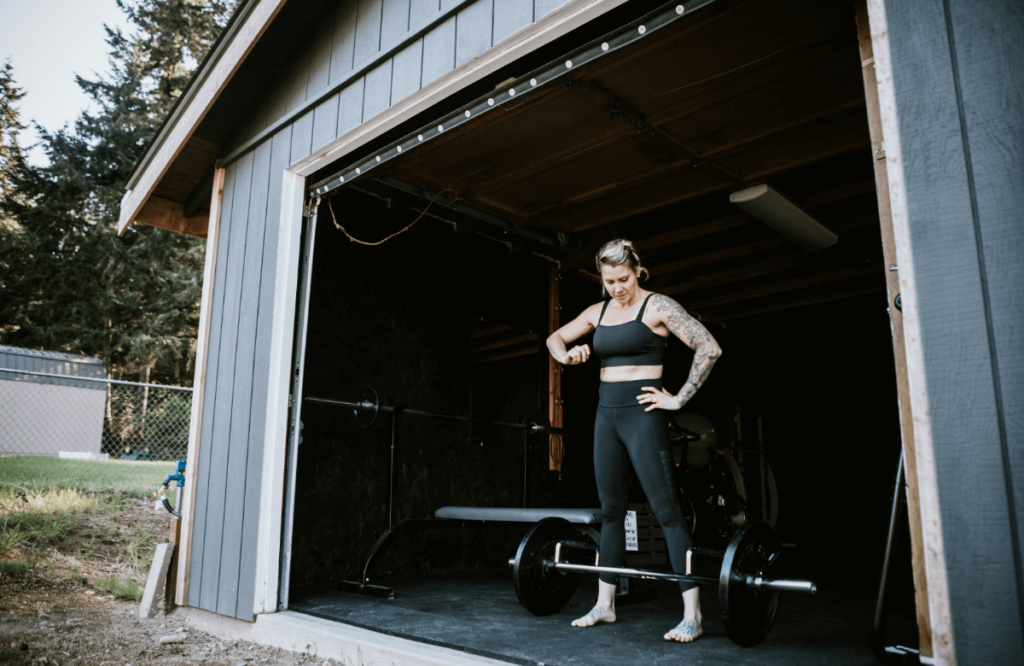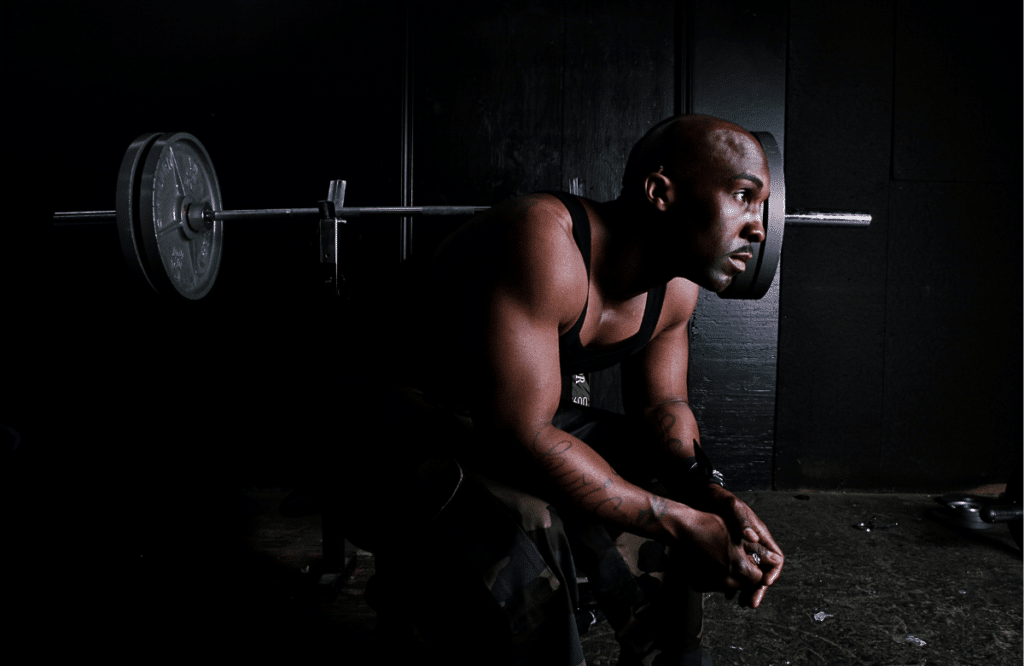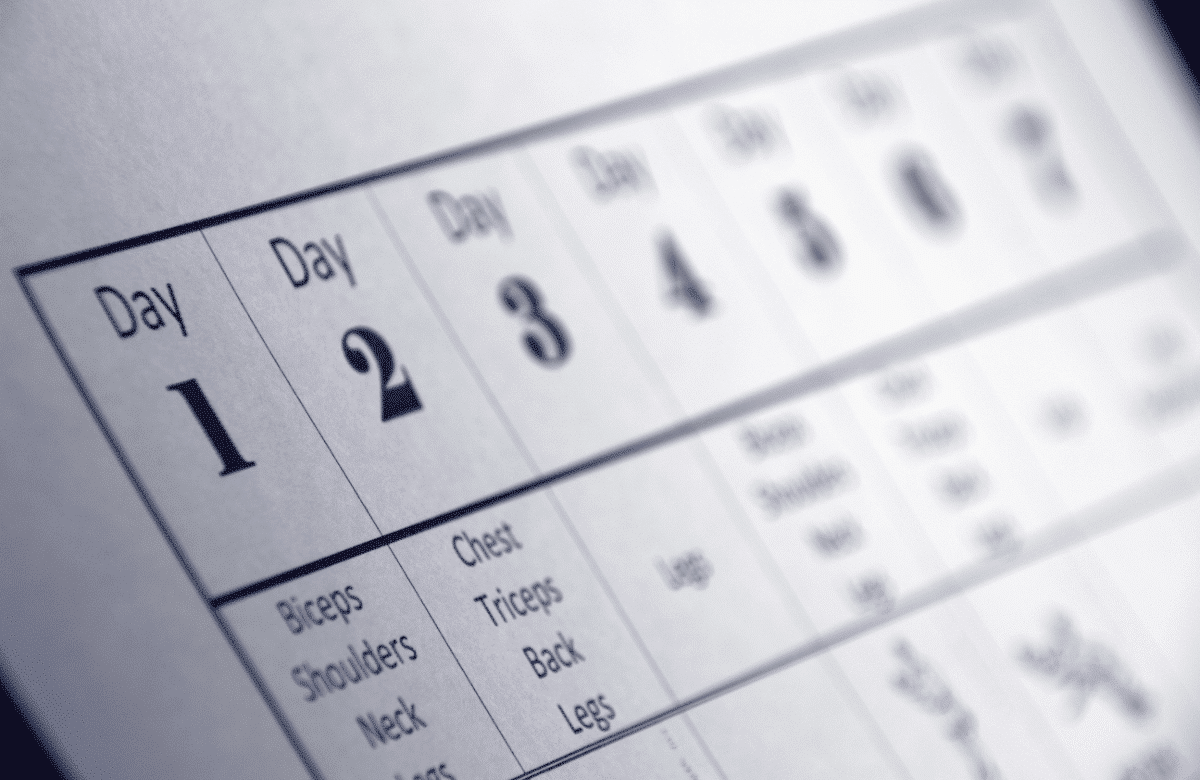In the pursuit of a healthier and fitter lifestyle, one of the key challenges many individuals face is finding the time to exercise, especially during the workweek. However, with a well-structured workout plan, you can efficiently use your limited time to achieve impressive results. In this article, we will explore the concept of a split workout and present the best 5-day workout schedule for those looking to optimize their fitness routine.
Jump to:
- What Is A Split Workout?
- Exploring an Effective 5-Day Workout Schedule:
- Advantages of 5-Day Workout Splits
- Potential Drawbacks of 5-Day Workout Splits:
- Rules of the Five-Day Split
- Full-Body Workouts: Pros And Cons
- Split Workouts: Pros And Cons
- Frequently Asked Questions (FAQs)
- What is the ideal workout duration for each day in the 5-day split routine?
- Can I customize the 5-day split routine to fit my specific goals?
- Is it necessary to take a rest day during the 5-day split workout plan?
- How do I know if I’m overtraining in a split routine?
- Can beginners follow a 5-day split routine, or is it better suited for experienced individuals?
- Should I always follow the same exercises in my split routine, or can I change them over time?
- What role does nutrition play in a successful 5-day split workout plan?
- How long does it take to see results with a 5-day split routine?
What Is A Split Workout?
A split workout, also known as a split routine, is a structured approach to exercise that involves dividing your training sessions into specific muscle groups or body parts on different days of the week. Instead of working the entire body in each workout session, as is common in full-body workouts, split workouts focus on isolating and targeting particular muscle groups during each training session. This approach allows for more concentrated and specialized training for each muscle group, optimizing muscle development, strength gains, and overall fitness.
There are several common split routines, and the choice of which one to follow often depends on individual goals, preferences, and training experience. Here are a few examples:
Body Part Split
In a body part split routine, each day of the week is dedicated to a specific muscle group or body part. For instance, one day might focus on chest and triceps, another on back and biceps, and so on. This type of split is popular among bodybuilders looking to achieve well-defined, sculpted muscles.
Upper-Lower Split
In an upper-lower split, the week is divided into two main workouts: upper body and lower body. Upper body days include exercises for the chest, back, shoulders, and arms, while lower body days involve training the legs and core. This approach offers a balanced workout that targets both upper and lower body strength.
Push-Pull Split
A push-pull split categorizes exercises based on whether they involve pushing or pulling movements. Push days include exercises like bench presses and shoulder presses, which involve pushing motions, while pull days consist of exercises such as rows and pull-ups, which involve pulling motions. This split balances muscle engagement and promotes muscle symmetry.
Muscle Group Split
This type of split allows for even greater specialization by dedicating specific days to individual muscle groups, such as legs, chest, back, shoulders, and arms. It’s ideal for those looking to prioritize particular muscle development.
Hybrid Splits
Some individuals prefer hybrid splits, which combine elements of various split routines to create a customized workout plan that aligns with their unique goals and needs.
With that said, no split is techniqually better than other. It just depends on your goals, desires, and current physical level. We’re going to discuss body part splits for the best 5 day work week schedule, but you can interchange it with another split.

Exploring an Effective 5-Day Workout Schedule:
To truly optimize your fitness journey, it’s essential to consider the intricacies of a well-structured 5-day workout routine. In this regimen, we divide each day into a specific focus, allowing for targeted muscle group training while also providing ample rest and recovery. Let’s delve deeper into this thought-out, designed workout schedule:
Monday – Chest and Triceps
- Bench Presses: Target the pectoral muscles, promoting strength and definition.
- Push-Ups: Sculpt the triceps while engaging the chest muscles.
- Tricep Dips: Work synergistically with push-ups to develop the triceps, creating a balanced upper body.
- Chest Flyes: Isolate the chest muscles for further development.
- Tricep Kickbacks: Focus on the triceps for enhanced sculpting.
The week kicks off with a dedicated session aimed at enhancing your chest and triceps. This day’s exercises encompass a repertoire that includes bench presses, push-ups, tricep dips, chest flyes, and tricep kickbacks. Bench presses engage the pectoral muscles, fostering both strength and definition, while push-ups and tricep dips work synergistically to sculpt the triceps, creating a balanced upper body development.
Tuesday – Back and Biceps
- Pull-Ups: Strengthen the latissimus dorsi, rhomboids, and trapezius in your back.
- Rows: Engage the back muscles while promoting overall upper body strength.
- Bicep Curls: Isolate and shape the biceps, enhancing arm aesthetics and functional strength.
- Deadlifts: Work the lower back and hamstrings while also engaging the biceps.
- Chin-Ups: Further target the biceps and upper back muscles.
Moving onto Tuesday, it’s time to shift focus to your back and biceps. This dual muscle group workout is a dynamic combination, offering a comprehensive upper body experience. Engage your back muscles through exercises such as pull-ups, rows, deadlifts, and chin-ups, strengthening not only the latissimus dorsi but also the rhomboids, trapezius, and biceps.
Wednesday – Legs
- Squats: Engage quadriceps, hamstrings, and glutes for comprehensive lower body development.
- Lunges: Improve unilateral balance and strength in lower limbs.
- Leg Presses: Target quadriceps, hamstrings, and calves, completing your lower body workout.
- Romanian Deadlifts: Focus on hamstrings and lower back.
- Calf Raises: Enhance calf muscle development for strong and defined legs.
Midweek arrives with an emphasis on leg day, targeting your lower body’s muscle groups. Squats, lunges, leg presses, Romanian deadlifts, and calf raises take center stage here. Squats are renowned for their all-encompassing lower body engagement, focusing on quadriceps, hamstrings, and glutes. Lunges bring unilateral balance and strength to your lower limbs, while leg presses round out the day by working on your quadriceps, hamstrings, and calves.
Thursday – Shoulders
- Shoulder Presses: Isolate the deltoid muscles for broad and strong shoulders.
- Lateral Raises: Enhance deltoid definition and shoulder aesthetics.
- Front Raises: Further develop the deltoids, contributing to an overall upper body strength and appearance.
- Upright Rows: Target the traps and deltoids.
- Shrugs: Work on trap muscles for a well-rounded shoulder area.
Thursday’s workout regimen zeros in on shoulder development. Strong and well-defined shoulders are not only visually appealing but also vital for overall upper body strength. Shoulder presses, lateral raises, front raises, upright rows, and shrugs are the primary exercises for this day. These movements isolate the deltoid muscles, promoting broad shoulders and enhancing your overall upper body aesthetics.
Friday – Full-Body or Active Recovery
- Full-Body Workout: Customize your routine to address specific areas or fitness goals.
- Active Recovery: Opt for activities like yoga or light cardio to aid muscle recuperation, improve flexibility, and prepare for the upcoming week’s challenges.
As the workweek nears its end, Friday offers flexibility in your workout routine. You can choose to engage in a full-body workout, addressing any specific areas you feel need additional attention or variation. This option allows you to fine-tune your regimen according to your personal fitness goals and needs. Alternatively, you can opt for active recovery activities, such as yoga or light cardio. These activities aid in muscle recuperation, improve flexibility, and help prepare your body for the next week’s challenges.
This 5-day workout schedule harmonizes targeted muscle group training with strategic rest and recovery, laying the foundation for a well-rounded fitness journey. Whether you aspire for sculpted aesthetics or enhanced functional strength, this regimen can be adapted to suit your individual goals, ensuring progress and satisfaction in your fitness endeavors.
Advantages of 5-Day Workout Splits
- Targeted Muscle Group Focus: A 5-day split allows you to dedicate each workout day to specific muscle groups. This targeted approach enables you to thoroughly work and stimulate individual muscle groups, which can lead to greater muscle growth and definition over time.
- Adequate Rest and Recovery: With this split, you typically have a day of rest or active recovery between each workout day. This built-in recovery time helps prevent overtraining and reduces the risk of injury, as muscles have time to repair and grow.
- Variety and Versatility: A 5-day split provides room for variety in your workouts. You can customize exercises, rep ranges, and intensity to suit your goals. It’s also easier to incorporate different training techniques, such as strength, hypertrophy, or endurance training, into your routine.
- Progress Tracking: Targeting specific muscle groups on designated days allows you to track your progress more closely. You can monitor strength gains and muscle development in each group, which can be motivating and help you adjust your training as needed.
Potential Drawbacks of 5-Day Workout Splits:
- Time Commitment: A 5-day split requires a significant time commitment. If you have a busy schedule or limited time for exercise, it may be challenging to consistently complete five workouts per week.
- Recovery Needs: While rest days are built into the schedule, some individuals may still struggle with recovery, especially if they push themselves too hard during workouts. Adequate sleep, nutrition, and active recovery practices become crucial.
- Plateaus and Overtraining Risk: Focusing heavily on specific muscle groups can lead to plateaus or overtraining if not managed properly. It’s essential to incorporate deload weeks or periods of reduced intensity to allow for recovery.
- Goal Alignment: 5-day splits are ideal for muscle hypertrophy and bodybuilding goals but may not be the best choice for those primarily interested in cardiovascular fitness, weight loss, or sports-specific training.

Rules of the Five-Day Split
To make the most of your five-day split workout plan, let’s elaborate further on the essential rules:
- Eat Enough Protein: Protein is the building block of muscle. Ensure you consume an adequate amount of protein to support muscle growth and repair. Aim for a balanced diet that includes lean meats, dairy, legumes, and supplements if necessary.
- Don’t Hit the Same Muscles Over and Over: Allow sufficient time for muscle recovery by avoiding consecutive workouts for the same muscle group. This rule is crucial for preventing overtraining and reducing the risk of injury.
- Don’t Just Add Volume: While increasing the weight or repetitions in your workouts is essential for progress, remember that proper form is paramount. Adding weight without maintaining proper technique can lead to injuries.
- Use Multiple Rep Ranges: Incorporate a mix of high-repetition, low-weight and low-repetition, high-weight exercises for well-rounded development. This approach challenges your muscles in different ways, promoting both strength and endurance.
- Change It Up Every Once in a While: Periodically modifying your workout routine is crucial to prevent plateaus and keep your body challenged. Your muscles adapt to the stress you place on them, so introducing new exercises or altering your routine every few weeks can lead to continued progress.
Full-Body Workouts: Pros And Cons
Full-body workouts involve targeting multiple muscle groups in a single training session. This approach can be time-efficient and can help improve overall strength and conditioning. However, they may not provide the same level of muscle isolation and recovery as split workouts, which can hinder muscle growth and development.
One of the primary advantages of full-body workouts is their efficiency. They allow you to work on various muscle groups in a single session, making them an excellent choice for individuals with busy schedules. These workouts often incorporate compound exercises like squats, deadlifts, and bench presses, which engage multiple muscle groups simultaneously. This can lead to improved functional strength and overall fitness.
However, there are some drawbacks to full-body workouts. Since you’re targeting multiple muscle groups in one session, you may not be able to dedicate as much time and effort to each one compared to a split routine. This could limit the potential for muscle hypertrophy or specialization and make it more difficult to reach your personal goals. Additionally, full-body workouts require longer recovery times between sessions to allow the body to recuperate fully, which might limit the frequency of your workouts.

Split Workouts: Pros And Cons
Split workouts, as mentioned earlier, allow you to focus on specific muscle groups each day. This can lead to better muscle hypertrophy and recovery, making it a favored choice among bodybuilders and those looking to sculpt their physique. However, they require a longer time commitment throughout the week, which can be challenging for some individuals.
One of the primary benefits of split workouts is the ability to target specific muscle groups with precision. This approach is ideal for individuals looking to develop particular areas of their physique or for those who have specific goals in mind. For example, if you want to build a bigger chest, a split routine allows you to dedicate an entire day to chest exercises, ensuring maximum stimulation and growth.
Moreover, split workouts often allow for more variety in exercises and training techniques. You can incorporate advanced training methods like drop sets, supersets, and isolation exercises to challenge your muscles from different angles, leading to better overall development.
However, there are also drawbacks to split workouts. They require a more significant time commitment, as you’ll need to allocate separate days for different muscle groups. This can be challenging for individuals with busy schedules. Additionally, the risk of overtraining specific muscle groups can become a concern if you’re not careful about providing adequate rest and recovery.
Frequently Asked Questions (FAQs)
What is the ideal workout duration for each day in the 5-day split routine?
The duration of your workouts can vary depending on factors such as your fitness level, the number of exercises, and rest periods. Generally, aim for 45 minutes to 1.5 hours per session. Quality is more important than quantity, so focus on efficient, well-executed exercises.
Can I customize the 5-day split routine to fit my specific goals?
Absolutely! The beauty of a split routine is its flexibility. You can tailor it to your goals, whether it’s building muscle, improving strength, or increasing endurance. Consult with a fitness professional to create a personalized plan that aligns with your objectives.
Is it necessary to take a rest day during the 5-day split workout plan?
Yes, incorporating rest days is crucial for recovery and injury prevention. The “Friday – Full-Body or Active Recovery” option in the schedule provides an opportunity to rest or engage in light activities like yoga or stretching to aid recovery.
How do I know if I’m overtraining in a split routine?
Signs of overtraining may include persistent fatigue, decreased performance, mood swings, and increased susceptibility to illness. To avoid overtraining, ensure you’re getting enough rest, following proper nutrition, and paying attention to your body’s signals. If in doubt, consult a fitness expert.
Can beginners follow a 5-day split routine, or is it better suited for experienced individuals?
While a 5-day split routine can be adapted for beginners, it’s often recommended that newcomers to fitness start with simpler, full-body workouts to build a solid foundation. Gradually, as your strength and experience grow, you can transition to a split routine.
Should I always follow the same exercises in my split routine, or can I change them over time?
It’s advisable to periodically change your exercises to prevent plateaus and keep your workouts engaging. Introduce new exercises, vary your rep ranges, and modify your routine every few weeks to challenge your muscles in different ways.
What role does nutrition play in a successful 5-day split workout plan?
Nutrition is a crucial aspect of any fitness plan. Ensure you’re consuming enough calories to support your goals, and focus on a balanced diet with sufficient protein, carbohydrates, and healthy fats. Consult a registered dietitian for personalized dietary guidance.
How long does it take to see results with a 5-day split routine?
Results can vary widely based on factors like consistency, effort, diet, and genetics. Generally, you may start noticing improvements in strength and endurance within a few weeks, while significant muscle growth and body composition changes often take several months of consistent effort.













